Abstract
The triple condensation of cyclopentanone or indanone to trindane (C15H18) or truxene (C27H18), respectively, provides convenient access to molecular skeletons on which major fragments of the prototypical fullerene C60 can be assembled. In particular, early approaches (both organic and organometallic) towards sumanene, as well as the final successful synthesis, are described. Organometallic derivatives of trindane have been prepared in which Cr(CO)3, Mo(CO)3, [Mn(CO)3]+ or [(C5H5)Fe(CO)2]+ are η6-bonded to the central arene ring. The debromination of hexabromotrindane yields trindene, which forms a tri-anion to which as many as three organometallic fragments, such as Mn(CO)3, W(CO)3Me, or Rh(CO)2, may be attached. Truxene forms complexes whereby three metal fragments can bind either to the peripheral arene rings, or to the five-membered rings, and these can be interconverted via η6 ↔ η5 haptotropic shifts. Truxene also forms a double-decker sandwich with Ag(I) bridges, and decacyclene, C36H18, forms triple-decker sandwiches bearing multiple cyclopentadienyl-nickel or -iron moieties. The organic chemistry of trindane has been investigated, especially with respect to its unexpectedly complex oxidation products, which were only identified unambiguously via X-ray crystallography. The three-fold symmetric trindane framework has also been used as a template upon which a potential artificial receptor has been constructed. Finally, the use of truxene and truxenone derivatives in a wide range of applications is highlighted.
1. Introduction
The cyclopentadienide fragment is a component of many polycyclic systems, and their metal complexes are very numerous [1]. We focus here on the syntheses, structures and reactivity of three-fold symmetric ligands, such as trindane or trindene, and related frameworks whereby the molecular periphery has been augmented via the incorporation of additional benzo rings, as in truxene or decacyclene.
Trindane, tris(cyclopenteno)benzene, 1, first reported by Wallach in 1897 [2], is commonly prepared via the acid-catalysed condensation of three molecules of cyclopentanone [3], and was characterised via X-ray crystallography in 1964 [4]. Other trimerisation routes include the use of SiCl4 in ethanol at room temperature [5], TiCl4 in refluxing ethanol [6], or aqueous NH4Cl at high temperatures [7]. The bromination of trindane via the photolysis of Br2 in CCl4 gave hexabromotrindane, 2, [8,9], which upon debromination with zinc furnished both isomers of dihydro-1H-trindene, 3. Subsequent multiple deprotonation (Scheme 1) generated the trindene trianion, 4, ideally poised for reactions with a range of organometallic fragments.
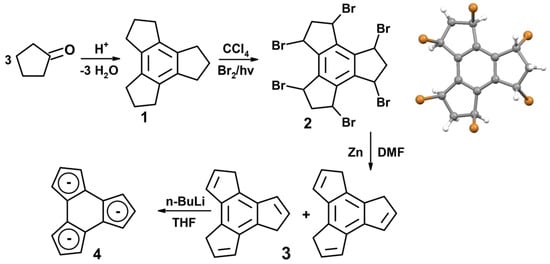
Scheme 1.
Syntheses of trindane, 1, and trindene, 3, via hexabromotrindane, 2 (CSD ID: KIKNIC).
2. Organometallic Derivatives of Trindane
2.1. Trindane Complexes of Chromium, Molybdenum, Manganese and Iron
The earliest report of an organometallic derivative of 1 appears to describe the formation of a series of cationic complexes of the type [99mTc(arene)2]+,, where the arene was C6H6, C6Me6, C6Et6, indane, trindane, etc. [10]. These materials were injected into rats to study the biodistribution of radioactive technetium to test their viability as myocardial imaging agents. These studies were, out of necessity, carried out on trace quantities of material, and no analytical or spectroscopic data were reported for [99mTc(trindane)2]+ [PF6]−, 5. In terms of the first fully characterised derivatives, complexes of the type (η6-trindane)MLn, where MLn = Cr(CO)3, 6, Mo(CO)3, 7, [Mn(CO)3]+, 8, or Fe(C5H5)+, 9, were each prepared via the reaction of trindane with an appropriate organometallic precursor (Scheme 2) [11].
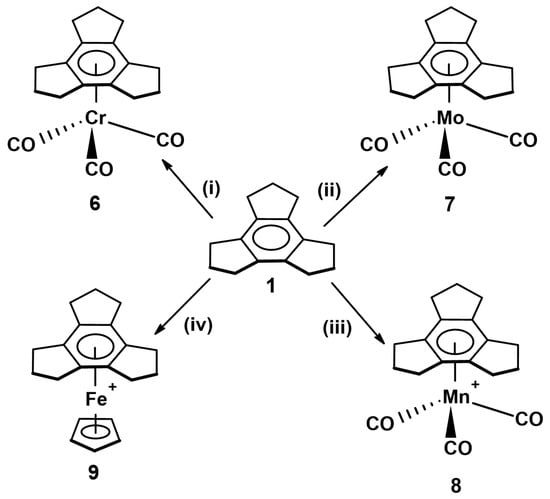
Scheme 2.
Syntheses of selected (η6-trindane)–metal complexes: (i) Cr(CO)6/Bu2O/THF, (ii) Mo(CO)6/THF, (iii) BrMn(CO)5/AgBF4/CH2Cl2, and (iv) (C5H5)Fe(CO)2I/AlCl3/CHCl3/AgBF4.
(η6-Trindane)Cr(CO)3, 6, forms yellow crystals, the structure of which appears in Figure 1, and reveals that the tripodal moiety is oriented such that the three carbonyl ligands are staggered with respect to the cyclopentenyl rings. These five-membered rings adopt envelope conformations such that the three methylene “wingtips” are folded in an endo fashion relative to the metal [11]. This may be compared to the structures of the previously known molecules [tris(cyclohexene)benzene]MLn, where MLn = Cr(CO)3 or [Mn(CO)3]+, 10, which also crystallise in a staggered tripodal orientation, but their peripheral six-membered rings exhibit conventional half-chair conformations [12].
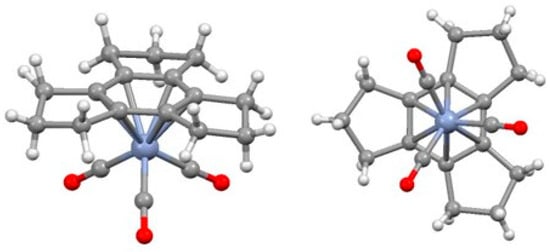
Figure 1.
Molecular structure of (η6-trindane)Cr(CO)3, 6 (CSD ID: NEVVOZ), showing (left) the folding of the central wingtip methylene groups towards the metal, and (right) the staggered orientation of the tripod.
It was noteworthy that in the mass spectra of the neutral complexes of (η6-trindane)M(CO)3, where M = Cr or Mo, peaks with m/z values corresponding to those of [(trindane)2M2(CO)3]+ were observed, leading to the speculation of the formation of triple-bridged systems of the type [(η6-trindane)M(μ-CO)3M(η6-trindane)]+, 11, entirely analogously to known 30-electron systems such as (η5-C5Me5)Re(μ-CO)3Re(η5-C5Me5) [13].
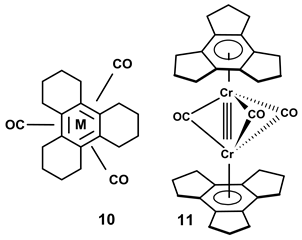
Trindane itself exhibits a very simple 1H NMR spectrum, i.e., a triplet (12H) for the benzylic protons and a quintet (6H) for the wingtip methylene groups. The incorporation of a π-complexed organometallic fragment renders the faces of the trindane ligand inequivalent, thus giving rise to four 1H NMR environments in complexes such as 6 through 9. The benzylic protons (each 6H) are readily distinguished from the resonances for the wingtip methylenes (each 3H) by their relative intensities, but their assignment to exo or endo positions is less trivial. However, the X-ray data for the chromium complex, 6, provide a rational means of assigning these resonances. Figure 2 illustrates the dihedral angles between a pair of benzylic hydrogens and those of the neighbouring wingtip methylene group within a five-membered ring. In all cases, the endo-benzylic hydrogen and its adjacent exo-wingtip hydrogen make a dihedral angle of approximately 90°, which is typical of di-equatorial interactions, which, in accordance with the Karplus relationship relating dihedral angles to 3JH-H values, exhibit a rather small vicinal coupling constant (4–5 Hz). In contrast, the diaxial interaction between the exo-benzylic hydrogen and its endo-wingtip counterpart leads to a noticeably larger 3JH-H value (~12 Hz), thus allowing a straightforward assignment of all the resonances.
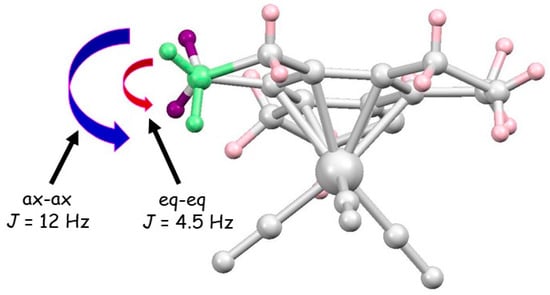
Figure 2.
View along the C(2)-C(1) bond of (trindane)Cr(CO)3, 6, showing the dihedral angles between the hydrogens of the central (wingtip) and benzylic methylenes.
2.2. Trindane Complexes of Ruthenium
An arene exchange reaction between [(p-cymene)RuCl2]2 and molten trindane was attempted and, gratifyingly, [(trindane)RuCl2]2 was produced in a 85% yield; its structure appears in Figure 3. In the solid state, the complex adopts the arrangement whereby the two ruthenium atoms are linked by two bridging chlorines, as in 12a, and each also possesses a terminally bonded chlorine. However, in solution, 1H-1H and 1H-13C two-dimensional NMR data clearly reveal the existence of a second species, the triple-bridged ionic isomer [(η6-trindane)Ru(μ-Cl)3(η6-trindane)]Cl, 12b, formed via the loss of a chloride ligand. These isomers are in a temperature-dependent equilibrium such that the ratio of 12a to 12b is 30:70 at −50 °C in CD2Cl2, but at room temperature in nitromethane CD3NO2 (which would surely favour the ionised species), this ratio changes dramatically to 1:10 [14].
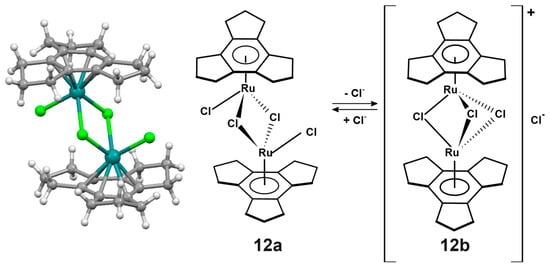
Figure 3.
Dynamic exchange between (trindane)RuCl((μ-Cl)2RuCl(trindane), 12a (NOMXOC), and [(trindane)Ru(μ-Cl)3(η6-trindane)]Cl, 12b.
We note parenthetically that hexaethylbenzene (HEB) may be thought of as an “unrestricted” trindane in which the wingtip methylene groups of the cyclopentenyl rings are now untethered, thus leaving them free to rotate. It was shown that the analogous ruthenium complex of HEB, i.e., [(HEB)RuCl2]2, also exists as an interconverting double- and triple-bridged species, but in this case both the double-bridged neutral species, 13a, analogous to 12a, and also the D3h-symmetric cation, 13b, analogous to 12b, together with its [C5(CO2Me)5]− counter-anion, have been characterised via X-ray crystallography (Figure 4) [15,16,17].
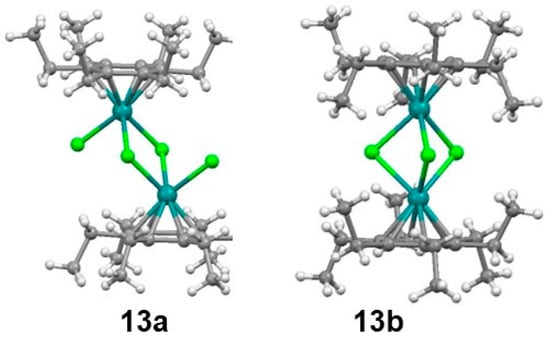
Figure 4.
Structures of (HEB)RuCl((μ-Cl)2RuCl(HEB), 13a (CSD ID: RXB7), and of the cation [(HEB)Ru(μ-Cl)3(HEB)]+, 13b (PENTEI).
When [(trindane)RuCl2]2, 12, was allowed to react with excess trindane in the presence of AgBF4, the sandwich compound [(η6-trindane)2Ru]2+ 2[BF4]−, 14, was isolated and fully characterised spectroscopically [14]. This molecule is, of course, the ruthenium analogue of the [99mTc(trindane)2]+ [PF6]− complex, 5, claimed, but never unambiguously identified, in the medicinal study of potential radio-labelled myocardial imaging agents noted above [10]. Finally, it was found that treatment of 12 with trimethyl phosphite delivered the anticipated monomeric species (η6-trindane)RuCl2[P(OMe)3], 15, the structure of which is shown in Figure 5.
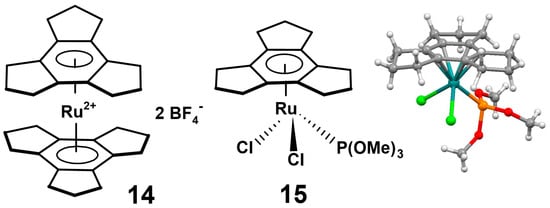
Figure 5.
[(η6-Trindane)2Ru]2+ 2[BF4]−, 14, and (η6-trindane)RuCl2[P(OMe)3], 15 (NOMXUI).
3. Organometallic Derivatives of Trindene
As noted above, Katz and Ślusarek prepared the trindene trianion, 4, which was then allowed to react with ferrous chloride to form bis(trindene)diiron, 16, as a red-brown material, along with traces of a tri-iron complex [8]. NMR data suggested that that the hydrocarbon rings in 16 are disposed as anti, as depicted in Scheme 3.
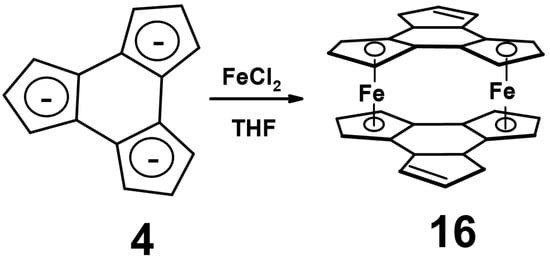
Scheme 3.
Reaction of the trindene trianion, 4, with FeCl2, to form bis(trindene)diiron, 16.
Almost four decades later, the first triple-metallocene derivative of trindene was prepared via the exchange reaction of the potassium salt of 4 with [Fe(C5H5)(η6-fluorene)]PF6 to yield the syn,syn,syn- and syn,syn,anti-isomers of (η5:η5:η5-trindenyl)[Fe(C5H5)]3, 17a and 17b, respectively, in a 1:3 ratio. The latter molecule was characterised via X-ray crystallography (Figure 6), which clearly showed a notable deviation of two five-membered rings in the trindene skeleton from planarity caused by the need to relieve repulsive non-bonding interactions between the syn ferrocenyl groups [18].

Figure 6.
Reaction of trianion, 4, with [Fe(C5H5)(η6-fluorene)]PF6 to form 17a and 17b (NODZUC).
The organometallic chemistry of trindene was considerably extended by Lynch and Rheingold, who successfully characterised a series of trimetallic derivatives bearing manganese- or rhenium-tricarbonyl fragments. The treatment of dihydro-1H-trindene, 3, with KH and either Mn(CO)3(py)2Br (py = pyridine) or [Re(CO)3(THF)Br]2 delivered (η5:η5:η5-trindenyl)[M(CO)3]3, where M = Mn or Re, 18 or 19, respectively (Scheme 4). As was found in 17b, the X-ray crystal structure of 19 (Figure 7) revealed that the metals were situated in a syn,syn,anti-fashion such that the five-membered rings bearing the cis rhenium units were bent away from each other and out of the central plane by ~10°, and that the Re(CO)3 groups exhibited maximal staggering of their carbonyl ligands [19]. It was also established that when only two metal carbonyl moieties were introduced, they adopted a trans geometry, 20, thus facilitating the introduction of a third different substituent, thereby forcing the cis disposition of the heterometals, as in the (trindenyl)Re2Rh(CO)8 complex, 21.

Scheme 4.
Manganese, rhenium and rhodium complexes of trindene.
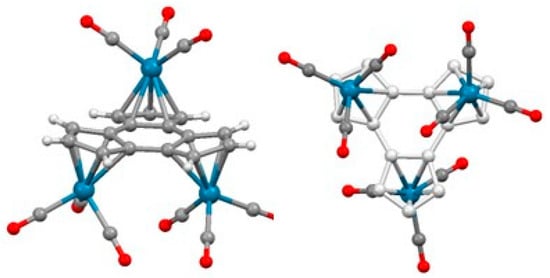
Figure 7.
Structure of (η5:η5:η5-trindenyl)[Re(CO)3]3, 19, showing the syn,syn,anti-configuration of the metal carbonyl groups, and the maximal staggering of the tripods (CSD ID: KARKAH).
In these systems, two of the metal fragments are necessarily positioned proximate to each other on the same face, and this feature has been exploited in a series of tri-molybdenum or tri-tungsten complexes. When the trindene trianion, 4, was treated with Mo(CO)6 and then with methyl iodide, the major product was syn,syn,anti-(η5:η5:η5-trindenyl)[Mo(CO)3Me]3, 22, along with a lower quantity of a material, 23, in which the two adjacent molybdenum atoms had lost their methyl substituents and formed a metal–metal bond. The tungsten congener behaved similarly, and the structure of the corresponding benzyl analogue, 24, possessing a tungsten–tungsten linkage was verified via X-ray crystallography, as shown in Figure 8 [20].

Figure 8.
Trimetallic molydenum or tungsten complexes of trindene, 22, 23, and 24 (CESWII).
The electrochemical behaviour of a number of these trimetallic derivatives of trindene was studied via cyclic voltammetry (CV). It was found that the complexes (trindenyl)(MLn)3, where MLn = Mn(CO)3, 18, or Rh(1,5-cyclooctadiene), 25, showed three well-defined, reversible one-electron oxidation reactions. In the rhodium case, the observed formal potentials are −0.33, −0.16 and +0.43 V, for the couples 25–25+, 25+–252+ and 252+–253+, respectively, and this abnormally large separation in potentials has been interpreted in terms of a Class III (totally delocalised) system [21]. There is also a report of the tri-rhodium complex, (η5:η5:η5-trindene)[Rh(1,5-COD)]2Rh(CO)2, 26, whose structure is shown in Figure 9 [22]. Since the two Rh(COD) fragments occupy anti positions, one can assume that they were coordinated initially, and the Rh(CO)2 unit was added subsequently.

Figure 9.
A trimetallic complex of trindene, 26 (WUXWUJ), bearing different rhodium fragments.
The CV scan of the triferrocenyl system 17b proceeds in two well-defined and reversible (chemically and electrochemically) one-electron steps with values of 0.23 and 0.61 V, for the first and second oxidations; however, this is followed by a chemically irreversible process (0.94 V) showing that the trication precipitates on the Au electrode [18]. Finally, we note that the charge transfer properties of multi-ferrocenyl dihydro-1H-trindenes, 27, have been investigated [23].
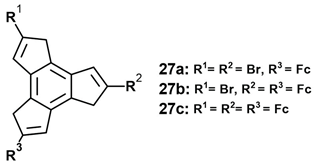
4. Metal Complexes of Truxene
Using the analogy of the self-condensation of cyclopentanone to form trindane, the analogous reaction of indanone yields C3h-symmetric truxene, C27H18, 28. It was first obtained accidentally by Hausmann in 1889 [24] during the synthesis of indanone from 3-phenylpropanoic acid, but the mechanism involving the intermediate tetracyclic ketone shown in Scheme 5 was only elucidated many years later [25].
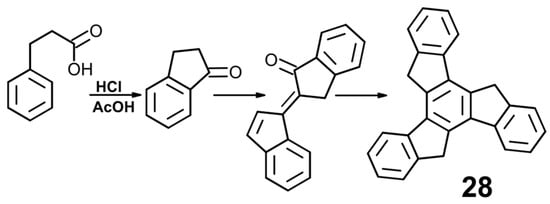
Scheme 5.
Hausmann’s original (1889) synthesis of truxene.
The deprotonation of truxene with KH in the presence of Mn(CO)3(py)2Br yielded truxene–manganese adducts with one, two or three Mn(CO)3 units bound to five-membered rings of the truxenyl ligand, whereby in (η5:η5:η5-truxenyl)[Mn(CO)3]3, only the syn,syn,anti-isomer, 29a, was obtained. However, these products can also be accessed via η6-to-η5 haptotropic shifts of arene-coordinated [Mn(CO)3]+ fragments in [(η6:η6:η6-truxenyl){Mn(CO)3}3]3+, which is formed as both the syn,syn,anti- and all-syn isomers, 30a and 30b, respectively; this provides the only route to the all-syn isomer 29b (Scheme 6) [26].
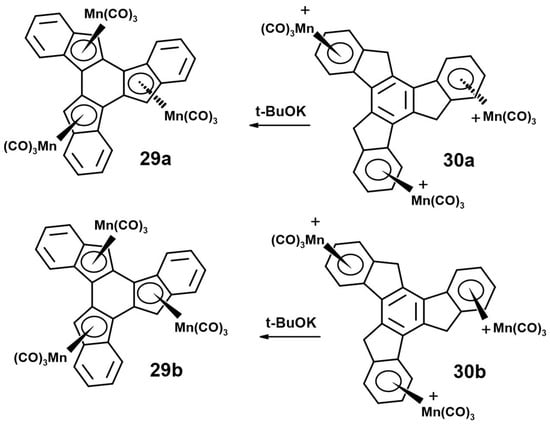
Scheme 6.
Neutral (η5:η5:η5) and tricationic (η6:η6:η6) manganese tricarbonyl complexes of truxene.
Truxene also reacts with silver perchlorate to form the dimeric sandwich compound [(μ2:μ2-truxene)2(η1-toluene)(H2O)Ag2(ClO4)2], 31, in which the truxenes are linked by Ag(I) bridges, each bonded in a dihapto fashion to peripheral arene rings, as depicted in Figure 10 [27].
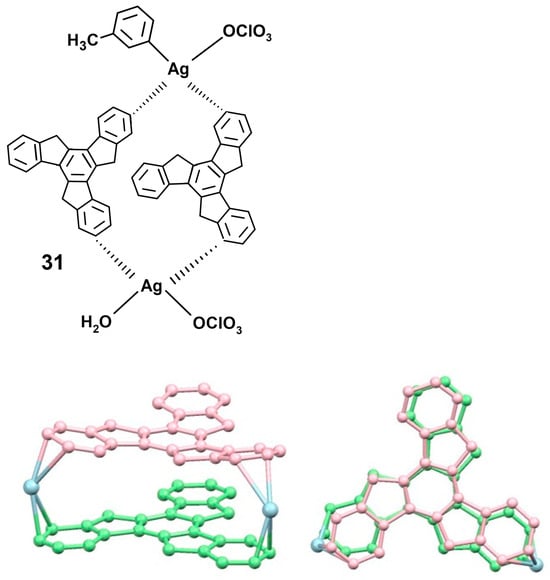
Figure 10.
Side view (left) and bird’s eye view (right) of (truxene)2Ag2, 31 (OZOYUZ), with hydrogens and peripheral ligands removed for clarity.
5. Metal Complexes of Decacyclene
Decacyclene, C36H18, 32, was first obtained by Dziewonski in Krakow, Poland, in 1903 upon the dehydrogenation of acenaphthene with elemental sulphur at 205–295 °C [28]. It differs from truxene in terms of the incorporation of additional peripheral benzo rings, thus apparently recovering the D3h symmetry of its trindenyl central core. However, the X-ray structure of decacyclene revealed it to be a shallow molecular propeller of D3 symmetry as the result of non-bonded repulsions between hydrogens of the peripheral naphthalene groups. This feature is clearly illustrated in the side view of 32 depicted in Figure 11. Interestingly, crystals of decacyclene also have a helical morphology, which is most pronounced when grown from solutions in organic solvents [29].
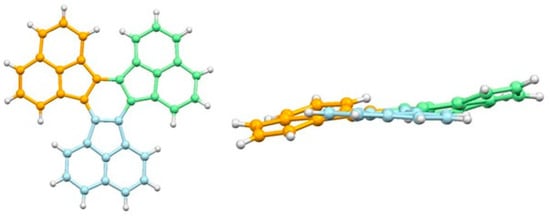
Figure 11.
Molecular structure of decacyclene, 32 (TONLEN); (left) bird’s eye view, (right) side view.
A more elegant route (Scheme 7) has been reported that takes advantage of the palladium-catalysed trimerisation of strained cycloalkynes. The caesium fluoride-initiated elimination of fluorotrimethylsilane and triflate from the disubstituted acenaphthene, 33, brought about the in situ formation of acenaphthyne, 34, which underwent cyclisation to form decacyclene in a 23% yield [30].
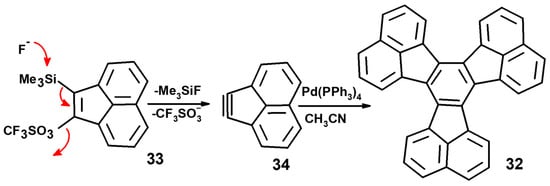
Scheme 7.
Palladium-catalysed trimerisation route to decacyclene.
Several triple-decker metal complexes of decacyclene have been reported from the Schneider group in Essen, Germany. The reduction of decacyclene in THF with potassium metal led to a red-brown solution containing polyanionic species that were allowed to react with organometallic reagents. Treatment with (η5-C5Me4Et)Ni(η2-acac) furnished black crystals of [(η5-C5Me4Et)Ni]2(μ-η3:η3)decacyclene], 35, in which the two organo-nickel fragments were each bonded in an η3-fashion to opposite faces of the central arene ring (Figure 12) [31].
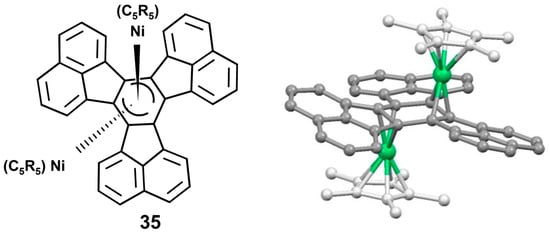
Figure 12.
Molecular structure of the decacyclene-dinickel triple-decker 35 (QOWKIW).
The analogous reaction with (η5-C5Me4Et)FeCl(tmeda), where tmeda is N,N,N′,N′-tetramethylethylenediamine, yielded two black crystalline products with the structures [(η5-C5Me4Et)Fe]2(μ2-η6:η6)decacyclene], 36, and [(η5-C5Me4Et)Fe]4(μ2-η6:η6:η6:η6)decacyclene], 37. In the former case, the organo-iron fragments were attached to opposite faces of the same naphthalene unit, as shown in Scheme 8. Metal complexation in 37 occurs in an alternating up/down fashion on two naphthalene moieties, and the molecule adopts a gently twisting propeller geometry in accordance with the topology of the decacyclene skeleton (Figure 13). It is notable that the Fe-C distances to the bridging carbon atoms are longer than those to the others since the two electrons connecting them must be shared between the two metals, thereby satisfying the 18-electron rule [32].
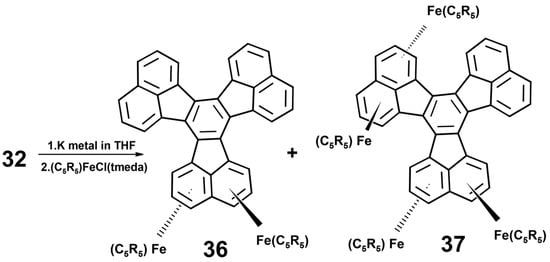
Scheme 8.
Formation of decacyclene di-iron, 36, and tetra-iron, 37, complexes.
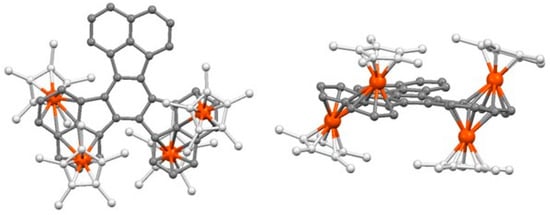
Figure 13.
Bird’s eye and side views of [(η5-C5Me4Et)Fe]4(μ2-η6:η6:η6:η6)decacyclene], 37 (SEDHUF).
6. Towards Sumanene
6.1. The Pyrolytic Approach
Although C60, with its “soccer-ball” icosahedral (Ih) symmetry, is preparable via the evaporation of graphite under appropriate conditions, and is now commercially available, attempts to develop logical stepwise synthesis continue to be explored. Two major components of the C60 skeleton are corannulene C20H10, 38, which possesses a central pentagon surrounded by five six-membered rings, and sumanene C21H12, 39, which has alternating five- and six-membered rings around a central hexagon; both are illustrated in Figure 14. Corannulene is now available in kilogram quantities, thanks to the pioneering contributions of Larry Scott (in Nevada) and Jay Siegel (in Zurich), and this work has been comprehensively reviewed [33,34,35,36]. However, in 1997, when the organometallic chemistry of trindane was still in its early stages, no route to sumanene had been reported, and success was only achieved some years later (see below).
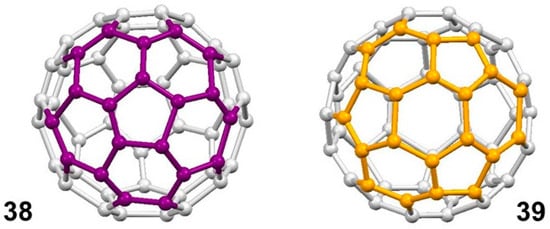
Figure 14.
Corannulene, 38, and sumanene, 39, shown as components of the C60 framework.
The bowl-shaped C3v-symmetric molecule sumanene, with its central six-membered ring surrounded by alternating five- and six-membered rings, was first postulated by Mehta in 1993; its name is derived from the Sanskrit word suman, which translates into “flower”, whereby the ring edges are considered to resemble petals. The earliest synthetic approach (Scheme 9) involved the palladium-mediated thermolysis of C3h-symmetric 1,5,9-trimethyltriphenylene, 40, in an attempt to bring about multiple dehydrogenations and subsequent ring closures; however, only the mono-bridged product, 41, was formed. Under even more forceful conditions, the flash vacuum pyrolysis (FVP) of 1,5,9-tri(bromomethyl)triphenylene, 42, led to the double-bridged species 43, which was characterised via X-ray crystallography [37].
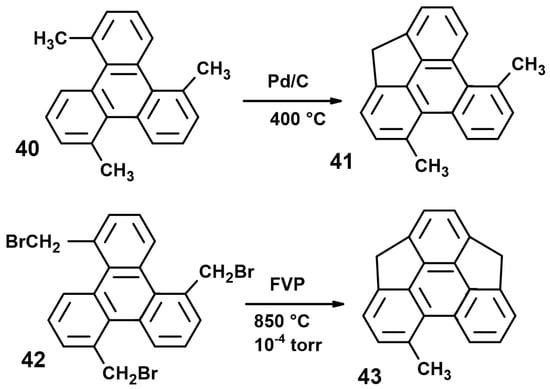
Scheme 9.
Mehta’s pioneering work on a potential route to sumanene.
These experimental observations validate the computational results of Priyakumar and Sastry, which revealed that all these cyclopentenation steps lead to an increase in strain, with the third endothermic step leading to an increase of more than 50 kcal/mol, making the final ring closure almost impossible. In contrast, starting from trindane (thereby incorporating the five-membered rings early on in the procedure) and then generating the six-membered peripheral rings subsequently is a thermodynamically favoured process [38,39].
6.2. The Proposed Organometallic Approach
Retrosynthetic analysis (Scheme 10) suggested a strategy starting from the cationic species [(trindane)Mn(CO)3]+, 8, whereby multiple deprotonation at the benzylic positions with subsequent attack by an electrophile could lead to a system, 44, bearing six bromomethyl substitutuents. The attachment of the organometallic fragment to the central arene ring would be expected to block that face and thereby favour exo attack by incoming electrophiles. Ring closure to form the bromosulfide 45, oxidation to the corresponding sulfone, followed by a Ramberg–Bäcklund rearrangement (a standard technique for the formation of small rings [40]) of the triple halosulfone, 46, should result in the elimination of HBr and SO2 and the direct formation of the new alkene moieties, leaving only a final dehydrogenation step.
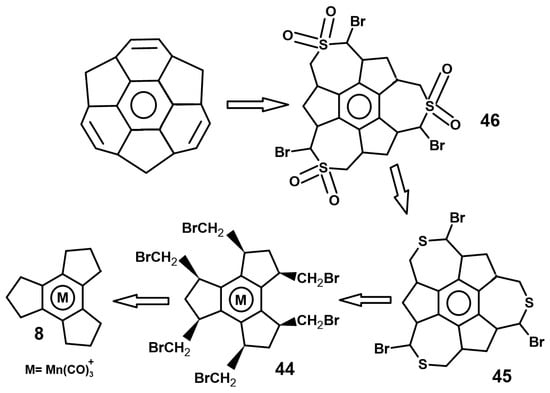
Scheme 10.
Proposed route from trindane to sumanene, via an organometallic intermediate.
This approach was predicated on earlier work by Astruc [41] on the multiple successive deprotonations at benzyl positions in [(η6-C6Me6)Fe(C5H5)]+, 47, to initially form (η5-Me5C6=CH2)Fe(C5H5), 48, which reacted with a range of electrophiles. This concept was further developed by Eyman [42] using the isoelectronic manganese system [(η6-C6Me6)Mn(CO)3]+, 49, as exemplified in Scheme 11. Moreover, it was found that substitution of a carbonyl ligand by a phosphine, as in [(η6-C6Me6)Mn(CO)2PMe3]+, increases the electron density on manganese and enhances the nucleophilicity of the exocyclic methylene group [43].
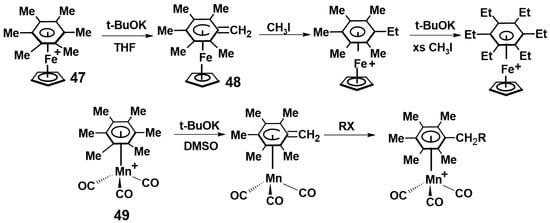
Scheme 11.
Substitutions at the benzylic position in (arene)iron or (arene)manganese cations.
To test this approach, [(trindane)Fe(C5H5)]+, 9, was deprotonated by t-BuOK in the presence of excess methyl iodide and yielded a product mixture in which up to twelve benzylic positions had been substituted, as shown in Scheme 12. The analogous reaction with allyl bromide also delivered the dodeca-substituted material.

Scheme 12.
Substitution at multiple benzylic positions in [(trindane)Fe(C5H5)]+.
In an attempt to hinder the approach by an electrophile to the endo face of the polycyclic ligand, the cyclopentadienyl-iron fragment was replaced by the more voluminous tricarbonylmanganese moiety. However, when [(trindane)Mn(CO)3]+, 8, was deprotonated by t-BuOK in the presence of excess allyl bromide, a red crystalline product, obtained in 17% yield after chromatographic separation, was identified, surprisingly, as (trindane)Mn(CO)2Br, 50 (Scheme 13). This material is also readily prepared, in a 93% yield, via the reaction of 8 with trimethylamine N-oxide (to bring about the loss of a carbonyl ligand) and a subsequent reaction with n-Bu4N+Br−. Likewise, the reaction of 8 with t-BuOK and methyl iodide produced (trindane)Mn(CO)2I, 51 (15%). The X-ray crystal structures of 50 and 51, shown in Figure 15, reveal that, as in (trindane)Cr(CO)3, 6, the tripodal moiety is oriented such that its ligands are staggered with respect to the cyclopentenyl rings, which adopt envelope conformations with endo-folded wingtip methylene groups [44].
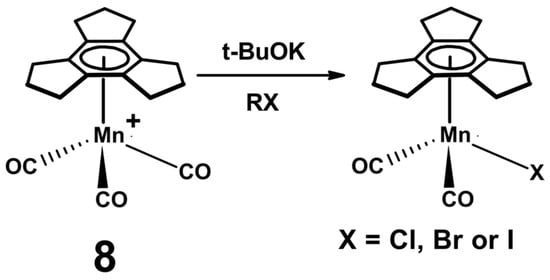
Scheme 13.
Formation of (trindane)Mn(CO)2X derivatives.
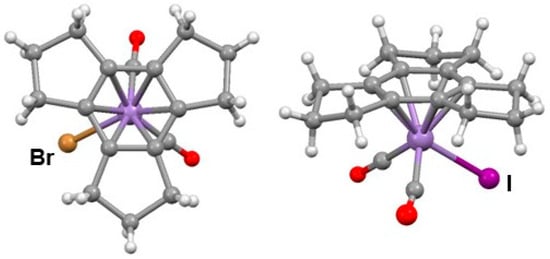
Figure 15.
Structures of (left) (trindane)Mn(CO)2Br, 50 (MOKROT), and (right) (trindane)Mn(CO)2I, 51 (YOQFEQ).
This contrasts the behaviour of [(C6Me6)Mn(CO)3]+, for which the displacement of a carbonyl ligand to form (C6Me6)Mn(CO)2X, where X = Cl, Br or I, requires either photolysis or a reaction with Me3NO in the presence of NaX [45]. It is also noteworthy that the treatment of (C6Me6)Mn(CO)2Cl with t-BuLi yields (C6Me6)Mn(CO)2H, 52, apparently via the elimination of isobutene from the presumed tert-butyl intermediate (Scheme 14). However, this hydride, which is sufficiently stable for its structure to be corroborated via X-ray crystallography [46], is more conveniently prepared via the reaction of (C6Me6)Mn(CO)2I with (n-Bu)4N+ [BH4]−; furthermore, 52 reacts readily with CCl4 or CHCl3, but not with CH2Cl2 to form (C6Me6)Mn(CO)2Cl [47].

Scheme 14.
Formation of (C6Me6)Mn(CO)2H, 52, via elimination of isobutene.
In light of these data, one can postulate a mechanism for the formation of (trindane)Mn(CO)2I upon the treatment of 51 with t-BuOK in the presence of methyl iodide. Since [(C6Me6)Mn(CO)3]+ is known to react with methanol to form the rather unstable ester (C6Me6)Mn(CO)2CO2Me [48], one can readily envisage the formation of the tert-butyl ester, 53, which readily eliminates isobutene and carbon dioxide via a very favourable six-membered transition state to produce (trindane)Mn(CO)2H, 54, as in Scheme 15. Treatment of 8 with t-BuOK in CH2Cl2 furnished (trindane)Mn(CO)2Cl, suggesting that 54 is more reactive than (C6Me6)Mn(CO)2H towards alkyl halides.

Scheme 15.
Proposed mechanism for the formation of (trindane)Mn(CO)2H, 54.
Since numerous attempts to prepare 54 via the treatment of (trindane)Mn(CO)2Br with (n-Bu)4N+ [BH4]−, or to detect the hydride signal via NMR were unsuccessful, an attempt was made to trap the purported metal hydride either as (trindane)Mn(CO)(PR3)H, or as the formyl complex (trindane)Mn(CO)(CHO)(PR3). When the cation 8 and tert-BuOK were treated with trimethyl phosphite in THF and kept at 40 °C for 20 h, the products isolated after chromatographic separation were yellow crystalline materials 55 and 56, the 1H and 13C NMR data of which indicated that the three-fold symmetry of the trindane ligand had been broken, as shown in Scheme 16. These products were unambiguously identified via X-ray crystallography as η5-indenyl complexes (Figure 16) in which the manganese had migrated from the central arene onto a five-membered ring that had evidently lost three hydrogens. The reaction with triphenylphosphine behaves analogously to give 57 [49].
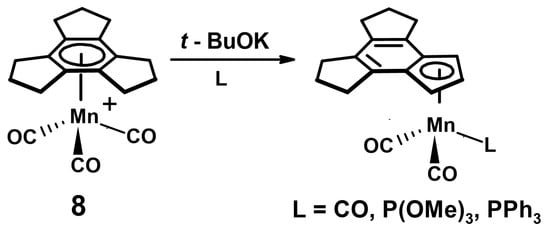
Scheme 16.
The haptotropic (η6 to η5) migration of the Mn(CO)3 tripod upon treatment with t-BuOK.
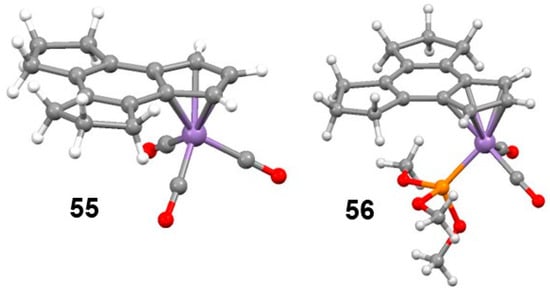
Figure 16.
Molecular structures of η5-complexes (left) 55 (YOQDEO) and (right) 56 (MOKRUZ).
In seeking a precedent for such behaviour, we note that King reported the reaction of [(η6-indane)Mn(CO)3]+ with t-BuOK and a phosphine to yield (η5-indenyl)Mn(CO)2L, where L = P(OMe)3 or PPh3 [50]. Furthermore, Crabtree and Parnell found that [(η6-indane)Ir(PPh3)2]+ underwent dehydrogenation and an η6-to-η5 haptotropic shift to yield [(η5-indenyl)Ir(PPh3)2(H)]+ [51]. Moreover, Ustynyuk and co-workers have shown that (η5-indenyl)Cr(CO)3Me, 58, undergoes a “ricochet reaction” in which the methyl is delivered to the five-membered ring and the tricarbonylchromium moiety migrates onto the six-membered ring, probably via an isoindene intermediate, 59, (Scheme 17) [52].

Scheme 17.
Ricochet reaction of (η5-indenyl)Cr(CO)3Me.
To account for the formation of the η5-bonded rearrangement complexes 55 and 56, we suggest that, in the absence of an alkyl halide, the initially generated (trindane)Mn(CO)2H, 54, undergoes hydrogen migration from an endo-benzyl site onto the metal, thus producing the cyclohexadienyl complex, 60, which in turn loses dihydrogen to give 61. A second round of endo-benzyl hydrogen migration to yield the isoindene framework, 62, is followed by the final round of hydrogen migration, producing 63. The loss of dihydrogen and the incorporation of either a carbonyl or phosphite ligand would give the observed products, 55 and 56, respectively, as depicted in Scheme 18 [49].
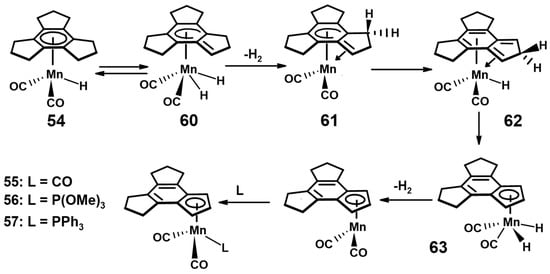
Scheme 18.
Proposed mechanism for the formation of the rearrangement products 55, 56 and 57.
7. The Synthesis of Sumanene
The synthesis of sumanene (Scheme 19) was finally achieved by Sakurai, Daiko and Hirao, who prepared a bromo-lithio derivative of norbornadiene, 64, that was converted into the corresponding tin compound 65. The copper-mediated trimerisation of 65 gave a 3:1 mixture of anti and syn benzotris(norbornadiene), 66, the latter of which underwent metathesis with the Grubbs catalyst to produce hexahydrosumanene, 67. The process was completed upon oxidation with DDQ to deliver sumanene, 39, with no need for a flash vacuum pyrolysis step [53]. This work has since been comprehensively reviewed recently [54,55].
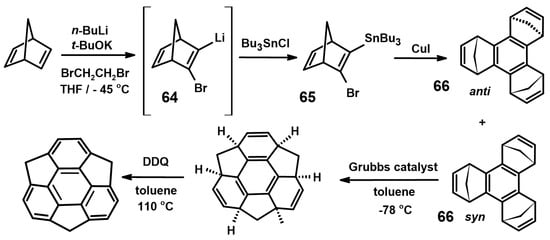
Scheme 19.
The Sakurai–Daiko–Hirao route to sumanene, 39.
8. Towards C60
8.1. From Decacyclene
As we know, the first well-characterised fullerene, C60, is now commercially available, but efforts towards a rational stepwise synthetic procedure continue to unfold [36]. As noted above, the chemistry of corannulene and sumanene have been well explored and numerous derivatives have been reported. Nevertheless, other elegant approaches based on three-fold symmetry have been disclosed. In particular, we note work by Scott, a major pioneer in the fullerene field, starting from decacyclene (Scheme 20). Having successfully prepared 8-chloro-1(2H)-acenaphthylenone, 68, this was trimerised using TiCl4 to produce 3,9,15-trichlorodecacyclene, 69, which upon FVP treatment at 1100 °C delivered a geodesic dome in a 27% yield with the formula C36H12, representing 60% of C60, and was given the trivial name Circumtrindene, 70 [56]. The structure was confirmed via X-ray crystallography [57], and Figure 17 illustrates this molecule as a component of the C60 framework.

Scheme 20.
Scott’s synthetic route to circumtrindene, 70.
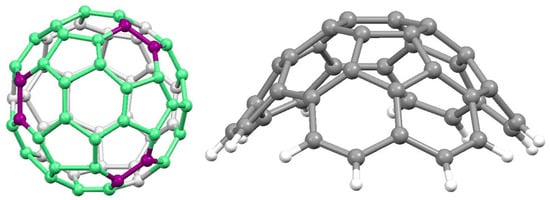
Figure 17.
Circumtrindene shown as 60% of the C60 skeleton; (left) the purple bonds indicate the final ring closures, and (right) the X-ray crystal structure of circumtrindene 70 (CSD ID: NARZEL).
8.2. The Designed Stepwise Synthesis of C60
The three-fold cyclisation of ketones, such as that of cyclopentanone to trindane, or indanone to truxene, is mirrored by the route to trichlorodecacyclene, 69, from 8-chloroacenaphthylenone, 68. Continuing with this approach, an even more audacious experiment by Scott and de Meijere sought to prepare C60 directly via the trimerisation of a C20 ketone. As shown in Scheme 21, the treatment of the pentacyclic ketone 71 with TiCl4 in refluxing o-dichlorobenzene led to the C3h-symmetric molecule, 72, with the formula C60H27Cl3. They were hoping to effect multiple dehydrohalogenations and dehydrogenations to bring about a “stitching together” of the three arms of the molecule via FVP at 1100 °C, thus forming C60 directly. Gratifyingly, this strategy was successful, and the only fullerene formed was C60; though in a very low yield, it was sufficient to be unambiguously characterised via mass spectrometry [58].
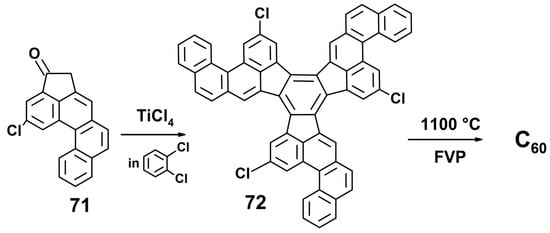
Scheme 21.
Stepwise synthesis of C60 via ketone trimerisation and FVP ring closures.
9. Organic Chemistry of Trindane
9.1. Oxidation of Trindane
The reported organic chemistry of trindane has focused primarily on its reactivity when treated with different oxidants. Ruthenium trichloride and sodium periodate, in situ, generate a ruthenium(VIII) species, “RuO4”, which reacted with trindane to bring about an unanticipated carbohydrate-like product, 72, the structure of which was elucidated via X-ray crystallography. One can envisage a mechanism whereby one of the double bonds in the aromatic ring is doubly hydroxylated to yield 73, and the subsequent cleavage of a second double bond forms a diketone that upon further oxidation and hydrolysis rearranges to deliver the final product (Scheme 22) [59].

Scheme 22.
Ru(VIII) oxidation of trindane to form 72.
In contrast, the ozonolysis of trindane led to 74, which again was only unequivocally characterised via X-ray crystallography (Scheme 23). Under these conditions, the initial cleavage of two double bonds of the central aromatic ring forms the tetraketone, 75, that is in equilibrium with its enol tautomer, 76, and cyclisation leads to the final product. The retention of the C15 periphery in 74 resembles the structure of some natural products, such as ginkgolides, and demonstrates that the cleavage of the π-bond endo to the cyclopentane present in trindane provides a simple route to complex natural products [60].

Scheme 23.
Ozonolysis of trindane to form 74 (CSD ID: OZ4).
More recent work has revealed that the result of the Ru(VIII) oxidation of the next higher homologue of trindane, dodecahydrotriphenylene, 77, which is readily prepared via the cyclisation of cyclohexanone, differs from that found with trindane. In this case, the central aromatic ring remains intact and the products arise from benzylic oxidation to the mono-, di- and tri-ketones 78, 79 and 80, respectively, depending on the length of the reaction time (Scheme 24) [61]. Interestingly, the products maintain their directionality such that the ketones are arranged unidirectionally (note that the cyclohexanone rings adopt their normal non-planar geometry).

Scheme 24.
Ru(VIII) oxidation of dodecahydrotriphenylene to form benzylic ketones.
9.2. Synthesis of a Potential Artificial Receptor
In a particularly elegant example that takes advantage not only of the three-fold symmetry of trindane, but also of the ability of an organometallic fragment to block one face of the arene, these concepts were exploited to investigate the construction of artificial receptors. As illustrated in Scheme 25, the hexaester 81 was prepared from 1,3,5-tris(bromomethyl)-2,4,6-tris(chloromethyl)benzene via a reaction with the sodium enolate of diethyl malonate, whereupon saponification, decarboxylation and esterification produced a mixture of cis,cis,cis- and cis,cis,trans-trindane-2,5,8-tricarboxylic ester, 82. However, the treatment of the triester with either Cr(CO)6 or Mo(CO)6 to form 83 allowed the isolation of the all-syn isomer in a good yield. A subsequent reaction with LDA and benzyl bromide proceeded exclusively via exo attack to form the desired C3v-symmetric product. The subsequent removal of the metal carbonyl tripod with iodine to form 84, and further elaboration led to the urea derivative, 85, which was investigated for its anion-binding capability [62].
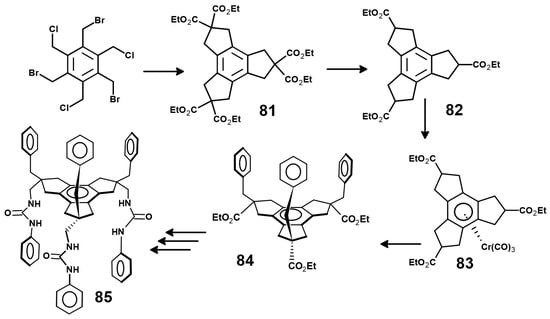
Scheme 25.
Construction of a C3v-symmetric potential artificial receptor.
10. Applications of Truxene and Truxenone
Truxene, 28, with its planar C3h symmetry, is an important building block for dendrimers, organic frameworks, and star-shaped, cage-like and porous molecules [63,64,65]. An early example of its application was its use in liquid crystals [66], but it has more recently found widespread utility in materials science [67], and in polymer chemistry [68], as a component of the stationary phase in capillary gas phase chromatography [69], as an organic sensitiser, or as a potential hole transport material in perovskite solar cells [70,71].
Truxenone, 86, was originally prepared directly via the acid-catalysed triple condensation of indane-1,3-dione [72,73], but the more recent five-step synthesis starting from 2-methylacetophenone (Scheme 26) proceeds under milder conditions and is more tolerant to sensitive substituents [74].
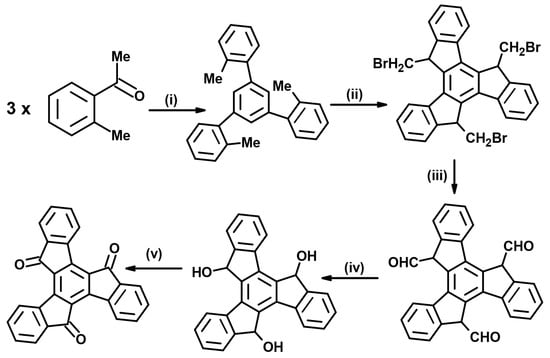
Scheme 26.
The multistep synthesis of truxenone under mild (room-temperature) conditions. (i) SiCl4, EtOH, (ii) NBS, AIBN, CCl4, (iii) NaOEt, Me2CHNO2, EtOH, (iv) gaseous BF3, benzene, (v) PCC, and CH2Cl2.
The ready availability of truxenone has led to the syntheses of a very large number of functionalised derivatives, many of which have been characterised via X-ray crystallography. A common feature that emerges in such structural determinations is the loss of planarity caused by steric crowding between the dicyanomethylene substituents at positions 5, 10 and 15 and the neighbouring peripheral aromatic rings. Typically, as shown in Figure 18, truxene maintains its C3h symmetry [75], whereas in the tris(dicyanomethylidene) system, 87, prepared via Knoevenagel condensation from truxenone (Scheme 27), the horizontal plane was broken, and the propeller-type molecule adopted a C3 symmetry and was chiral [76]. Truxenone has found applications in many areas ranging from organic voltaics [77], and n-type semiconductors [78], to serving as the framework for the cathode in a solid-state lithium-ion battery [79].
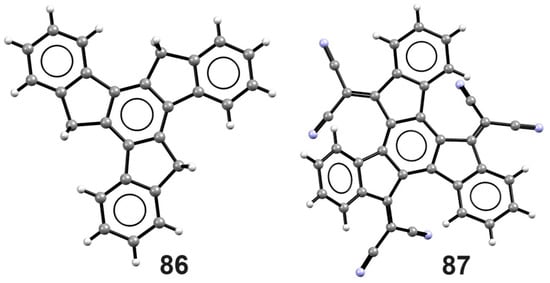
Figure 18.
Molecular structures of truxene, 86 (DEQPIC), and the hexacyanomethylidene derivative, 87 (MATWEJ).

Scheme 27.
A Knoevenagel reaction to form the hexacyanomethylidene derivative 87.
11. Concluding Remarks
The three-fold D3h symmetry of trindane, 1, or of the trindene trianion, 4, provides a versatile framework in which chemical structure and reactivity can be controlled. When an organometallic fragment, such as M(CO)3, is π-complexed to one face of trindane, it not only enhances the acidity of the exo-benzylic hydrogens, but also protects that face from approach by electrophiles. However, nucleophilic attack on the metal carbonyl ligands, with the elimination of specific fragments (such as isobutene or CO2), can bring about the formation of a metal–hydride linkage that opens up other reaction possibilities, as exemplified in Scheme 16.
When the trindene system bears three π-complexed organometallic units, at least two of them must be sited adjacently on the same face, thereby enhancing the likelihood of electronic interaction between the metals, or even the development of a formal metal–metal bond, as in Figure 8. The addition of three peripheral benzo rings, as in truxene, maintains the three-fold symmetry of the system but also offers different types of coordination sites whereby the organometallic moiety can bind in an η5 or η6 fashion. Moreover, protonation–deprotonation sequences can bring about haptotropic shifts between these two situations, as exemplified in Scheme 6.
The formation of decacyclene apparently regains the D3h symmetry of trindenyl, but this is not in fact the case. Non-bonded repulsions between hydrogens of neighbouring naphthyl groups cause the molecule to adopt a chiral (C3) propeller geometry that is even more evident when organometallic units are attached to opposite faces of the molecule.
It has long been hoped that functionalised versions of these polycyclic frameworks could lead towards a rational stepwise route to fullerenes, or at least to sizeable portions of the C60 skeleton. This approach was initially used in early attempts to prepare sumanene, and one spectacular example of success has been the controlled coupling of adjacent peripheral naphthyl rings in decacyclene to generate circumtrindene, C36H12, which contains 60% of the C60 framework.
Finally, one can only marvel at the complexity of the oxidation products of a molecule as simple as trindane, and the multitude of important applications, such as liquid crystals, optoelectronics, solar cell technology or solid-state batteries, in which truxene or truxenone plays such a crucial role.
Author Contributions
Conceptualisation, M.J.M.; writing—original draft, P.E.L., N.R., J.B.-C. and M.J.M. All authors have read and agreed to the published version of the manuscript.
Funding
This research was funded for many years by the Natural Sciences and Engineering Research Council of Canada (NSERC), the Petroleum Research Fund (PRF), administered by the American Chemical Society, and by Science Foundation Ireland (SFI).
Acknowledgments
The authors thank University College Dublin and the UCD School of Chemistry for additional financial support, and the Centre for Synthesis and Chemical Biology (CSCB) for the use of analytical facilities.
Conflicts of Interest
The authors declare no conflict of interest.
References
- Pammer, F.; Thiel, W.R. Benzannulated homologues of cyclopentadienide as ligands in organometallic chemistry. Coord. Chem. Rev. 2014, 270–271, 14–30. [Google Scholar] [CrossRef]
- Wallach, O. Über Condensationsproducte cyclischer Ketone. Chem. Ber. 1897, 30, 1094–1096. [Google Scholar] [CrossRef]
- Mayer, R. Syntheses mit Dicarbonsäuren, Zur Selbstkondensation des Cyclopentanons. Chem. Ber. 1956, 89, 1443–1454. [Google Scholar] [CrossRef]
- Boyko, E.R.; Vaughan, P.A. Crystal structure and molecular statics of trindan C15H18. Acta Cryst. 1964, 17, 152–153. [Google Scholar] [CrossRef]
- Elmorsy, S.S.; Pelter, A.; Smith, K. The direct production of tri-substituted and hexa-substituted benzenes from ketones under mild conditions. Tetrahedron Lett. 1991, 32, 4175–4176. [Google Scholar] [CrossRef]
- Li, Z.; Sun, W.-H.; Jin, X.; Shao, C. Triple self-condensation of ketones yielding aromatics promoted with titanium tetrachloride. Synlett 2001, 12, 1947–1949. [Google Scholar] [CrossRef]
- Kotsuki, H.; Mehta, B.K.; Yanagisawa, K. Novel synthesis of fully-substituted pyridine derivatives via self-condensation of cyclic ketones in aqueous ammonium chloride under hydrothermal conditions. Synlett 2001, 1323–1325. [Google Scholar] [CrossRef]
- Katz, T.J.; Ślusarek, W. The trindene trianion. J. Am. Chem. Soc. 1980, 102, 1058–1063. [Google Scholar] [CrossRef]
- Zhou, S.-J.; Xie, S.-Y.; Huang, R.-B. 1,3,4,6,7,9-Hexabromo2,3,4,5,6,7,8,9-octahydro-1H-trindene. Acta Cryst. Sect. E Struct. Rep. Online 2007, 63, 03819. [Google Scholar] [CrossRef]
- Wester, D.W.; Coveney, J.R.; Nosco, D.L.; Robbins, M.S.; Dean, R.T. Synthesis, characterization and myocardial uptake of cationic bis(arene)technetium(I) complexes. J. Med. Chem. 1991, 34, 3284–3290. [Google Scholar] [CrossRef]
- Gupta, H.K.; Lock, P.E.; McGlinchey, M.J. Metal complexes of trindane: Possible precursors of sumanene. Organometallics 1997, 16, 3628–3634. [Google Scholar] [CrossRef]
- Gommans, L.H.P.; Main, L.; Nicholson, B.K. Metal-carbonyl complexes of dodecahydrotriphenylene; a comparison of the structures of isoelectronic [(η6-C18H24)Mn(CO)3]+ and (η6-C18H24)Cr(CO)3. J. Organomet. Chem. 1988, 346, 385–395. [Google Scholar] [CrossRef]
- Hoyano, J.K.; Graham, W.A.G. Photochemistry of (η-C5Me5)Re(CO)3: Preparation and X-ray crystal structure of (η-C5Me5)2Re2(CO)3. J. Chem. Soc. Chem. Commun. 1982, 27–28. [Google Scholar] [CrossRef]
- Gupta, H.K.; Lock, P.E.; Hughes, D.W.; McGlinchey, M.J. Trindane-ruthenium sandwich complexes: An NMR and X-ray crystallographic study of [(trindane)RuCl2]2, (trindane)RuCl2[P(OMe)3], and [(trindane)2Ru][BF4]2. Organometallics 1997, 16, 4355–4361. [Google Scholar] [CrossRef]
- Baldwin, R.; Bennett, M.A.; Hockless, D.C.R.; Pertici, P.; Verrazzani, A.; Uccello, B.G.; Marchetti, F.; Salvadori, P. Synthesis, structures and dynamic NMR spectra of η6-hexaethylbenzene complexes of ruthenium(0) and ruthenium(II). J. Chem. Soc. Dalton Trans. 2002, 23, 4488–4496. [Google Scholar] [CrossRef]
- Gupta, H.K.; Lock, P.E.; Reginato, N.; Britten, J.F.; McGlinchey, M.J. Hexaethylbenzene complexes of ruthenium and manganese—X-ray crystal structures and NMR spectra of [(HEB)2 Ru2(μ-Cl)3][C5(CO2Me)5], [(HEB)Ru(H2O)3][BF4]2, (HEB)RuCl2[P(OMe)3], trans-RuCl2(PMe3)4, and (HEB)Mn(CO)2Br. Can. J. Chem. 2006, 84, 277–287. [Google Scholar] [CrossRef]
- McGlinchey, M.J. Hexaethylbenzene: A sterically crowded arene and conformationally versatile ligand. ChemPlusChem 2018, 83, 480–499. [Google Scholar] [CrossRef]
- Santi, S.; Orian, L.; Donoli, A.; Bisello, A.; Scapinello, M.; Bentollo, F.; Ganis, P.; Ceccon, A. Synthesis of the prototypical cyclic metallocene triad: Mixed-valence properties of [(FeCp)3(trindenyl)] isomers. Angew. Chem. Int. Ed. 2008, 47, 5331–5334. [Google Scholar] [CrossRef]
- Lynch, T.J.; Helvenston, M.C.; Rheingold, A.L.; Staley, D.L. Metal carbonyl complexes of the trindenyl ligand: Crystal structure of trans-[Re(CO)3]3(trindenyl). Organometallics 1989, 8, 1959–1963. [Google Scholar] [CrossRef]
- Lynch, T.J.; Carroll, J.M.; Helvenston, M.C.; Tisch, T.L.; Rheingold, A.L.; Staley, D.L.; Mahmoudkhani, A. Trindenyl trimolybdenum and tritungsten complexes: Crystal structure of (trindenyl)[(OC)3W-W(CO)3]WCO)3Bn. Organometallics 2012, 31, 3300–3307. [Google Scholar] [CrossRef]
- Winter, R.; Pierce, D.T.; Geiger, W.E.; Lynch, T.J. Stepwise oxidation of three communicating metal centres: Electrochemistry of trinuclear trindenyl complexes of manganese or rhodium. J. Chem. Soc. Chem. Commun. 1994, 17, 1949–1950. [Google Scholar] [CrossRef][Green Version]
- Rheingold, A.L.; (Cambridge Crystallographic Data Centre, Cambridge, UK); Geiger, W.E.; (Cambridge Crystallographic Data Centre, Cambridge, UK). CSD Private communication, 2015.
- Donoli, A.; Bisello, A.; Cardena, R.; Prinzivalli, C.; Santi, S. Charge transfer properties of multi(ferrocenyl)trindenes. Organometallics 2013, 32, 1029–1036. [Google Scholar] [CrossRef]
- Hausmann, J. Einwirkung von o-Cyanbenzylchlorid auf natriummalonester. Untersuchung des α-Hydrindons. Chem. Ber. 1889, 22, 2019–2026. [Google Scholar] [CrossRef]
- Górski, K.; Mech-Piskorz, J.; Pietraszkiewicz, M. From truxenes to heterotruxenes: Playing with heteroatoms and the symmetry of molecules. New J. Chem. 2022, 46, 8939–8966. [Google Scholar] [CrossRef]
- Tisch, T.L.; Lynch, T.J.; Dominguez, R. Polymetallic compounds of extended polyaromatic ligands. Rhenium and manganese carbonyl derivatives of truxene. J. Organomet. Chem. 1989, 377, 265–273. [Google Scholar] [CrossRef]
- Wombacher, T.; Foro, S.; Schneider, J.J. Synthesis and molecular structures of the cationic silver complexes of the polycondensed aromatics fluorene, pseudorubrene, and truxene. Eur. J. Inorg. Chem. 2016, 32, 5152–5160. [Google Scholar] [CrossRef]
- Dziewonski, K. Über Dekacyclen (Trinaphtylenbenzol) einen neuen hochmolekuren aromatischen Kohlenwasserstoff, und über Dinaphtylenthiophen, einen rothen Thiokörper. Chem. Ber. 1903, 36, 962–971. [Google Scholar] [CrossRef]
- Ho, D.M.; Pascal, R.A., Jr. Decacyclene: A molecular propeller with helical crystals. Chem. Mat. 1993, 5, 1358–1361. [Google Scholar] [CrossRef]
- Iglesias, B.; Peña, D.; Pérez, D.; Guitián, E.; Castedo, L. Palladium-catalyzed trimerization of strained cycloalkynes: Synthesis of decacyclene. Synlett 2002, 3, 486–488. [Google Scholar] [CrossRef]
- Schneider, J.J.; Spickermann, D.; Bläser, D.; Boese, R.; Rademacher, P.; Labahn, T.; Magull, J.; Janiak, C.; Seidel, N.; Jakob, K. A π-stacked organometallic propeller: Experimental and theoretical studies on reactivity and bonding in the π-arene-bridged nickel triple-decker [{η5-Me4EtC5)Ni}2(μ-η3:η3-decacyclene)]. Eur. J. Inorg. Chem. 2001, 2001, 1371–1382. [Google Scholar] [CrossRef]
- Schneider, J.J.; Spickermann, D.; Lehmann, C.W.; Magull, J.; Krüger, H.-J.; Ensling, J.; Gütlich, P. Decacyclene as complexation manifold: Synthesis, structure and properties of its Fe2 and Fe4 slipped triple-decker complexes. Chem. Eur. J. 2006, 12, 1427–1435. [Google Scholar] [CrossRef]
- Scott, L.T.; Hashemi, M.M.; Meyer, D.T.; Warren, H.B. Corannulene, A three-step synthesis. J. Am. Chem. Soc. 1997, 119, 10963–10968. [Google Scholar] [CrossRef]
- Butterfield, A.M.; Gilomen, B.; Siegel, J.S. Kilogram-scale production of corannulene. Org. Process. Res. Dev. 2012, 16, 664–676. [Google Scholar] [CrossRef]
- Yu, Y.T.; Siegel, J.S. Aromatic molecular-bowl hydrocarbons: Synthetic derivatives, their structures and physical properties. Chem. Rev. 2016, 106, 4843–4867. [Google Scholar] [CrossRef]
- Scott, L.T. Methods for the chemical synthesis of fullerenes. Angew. Chem. Int. Ed. 2004, 43, 4994–5007. [Google Scholar] [CrossRef] [PubMed]
- Mehta, G.; Shah, S.R.; Ravikumar, K. Towards the design of tricyclopenta[def,jkl,pqr] triphenylene (Sumanene): A bowl-shaped hydrocarbon featuring a structural motif present in C60 (Buckminsterfullerene). J. Chem. Soc. Chem. Commun. 1993, 12, 1006–1008. [Google Scholar] [CrossRef]
- Sastry, G.N.; Jemmis, E.D.; Mehta, G.; Shah, S.R. Synthetic strategies towards C60. Molecular mechanics and MNDO study on sumanene and related structures. J. Chem. Soc. Perkin Trans. 1993, 2, 1867–1871. [Google Scholar] [CrossRef]
- Priyakumar, U.D.; Sastry, G.N. Theory provides a clue to accomplish the synthesis of sumanene, C21H12, the prototypical C3v-buckyball. Tetrahedron Lett. 2001, 42, 1379–1381. [Google Scholar] [CrossRef]
- March, J. Advanced Organic Chemistry: Reactions, Mechanisms and Structure, 4th ed.; John Wiley & Sons: New York, NY, USA, 1992; pp. 1030–1032. [Google Scholar]
- Hamon, J.-R.; Saillard, J.-Y.; Le Beuze, A.; McGlinchey, M.J.; Astruc, D. Organometallic electron reservoirs. 7. One-step multiple formation of C-C bonds in CpFe(arene)+ sandwiches and unusual C6Et6 geometry in the X-ray crystal structure of CpFe+(η6-C6Et6)BF4−. J. Am. Chem. Soc. 1982, 104, 7549–7555. [Google Scholar] [CrossRef]
- LaBrush, D.M.; Eyman, D.P.; Baenziger, N.C.; Mallis, L.M. Preparation, characterization, and reactivity of (η5-pentamethylbenzyl)manganese tricarbonyl. Organometallics 1991, 10, 1026–1033. [Google Scholar] [CrossRef]
- Moler, J.L.; Eyman, D.P.; Neilson, J.M.; Morken, A.M.; Schauer, S.J.; Snyder, D.B. (η5-Benzyl) manganese complexes. 2. Preparation, characterization and reactivity of [η5-C6Me5(CH2)] Mn(CO)2PR3 (R = n-Bu, Me, Ph, OMe, OPh). Structure of [η5-C6Me5(CH2)]Mn(CO)2PMe3. Organometallics 1993, 12, 3304–3315. [Google Scholar] [CrossRef]
- Reginato, N.; McGlinchey, M.J. Unexpected reaction of (trindane)Mn(CO)3+ BF4− with potassium tert-butoxide: Three C-H insertions and a haptotropic shift. Organometallics 2001, 20, 4147–4149. [Google Scholar] [CrossRef]
- Bernhardt, R.J.; Eyman, D.P. Synthesis and characterization of (arene)manganese dicarbonyl halides and hydride. Organometallics 1984, 3, 1445–1446. [Google Scholar] [CrossRef]
- Schlom, P.J.; Morken, A.M.; Eyman, D.P.; Baenziger, N.C.; Schauer, S.J. Reactivity and structure of (η6-C6(CH3)6Mn(CO)2H: Stable alkylrhenium analogues. Organometallics 1993, 12, 3461–3467. [Google Scholar] [CrossRef]
- Bernhardt, R.J.; Wilmoth, M.A.; Weers, J.J.; LaBrush, D.M.; Eyman, D.P.; Huffman, J.C. Derivatives of the (arene)M(CO)2 fragment. The molecular structure of (η6-C6Me6)Mn(CO)2Cl. Organometallics 1986, 5, 883–888. [Google Scholar] [CrossRef]
- Walker, P.J.C.; Mawby, R.J. Patterns of nucleophilic attack on tricarbonyl π-arene complexes of manganese(I). Inorg. Chim. Acta 1973, 7, 621–625. [Google Scholar] [CrossRef]
- Reginato, N.; Harrington, L.E.; Ortin, Y.; McGlinchey, M.J. Unexpectedly different reactions of [(arene)Mn(CO)3]+ cations (arene = trindane, indane, tetralin or dibenzosuberane) with potassium t-butoxide—C-H insertions, haptotropic shifts, dimerization, or elimination. Can. J. Chem. 2009, 87, 232–246. [Google Scholar] [CrossRef]
- King, R.B. Organometallic chemistry of the transition metals XXIII. Some indenyl and fluorenyl derivatives of manganese carbonyl. J. Organomet. Chem. 1970, 23, 527–529. [Google Scholar] [CrossRef]
- Crabtree, R.H.; Parnell, C.P. Haptotropic rearrangements and C-H activation in indane, indenyl, and naphthalene complexes of iridium. Organometallics 1984, 3, 1727–1731. [Google Scholar] [CrossRef]
- Trifonova, O.I.; Ochertyanova, E.A.; Akhmedov, N.G.; Roznyatovsky, V.A.; Laikov, D.N.; Ustynyuk, N.A.; Ustynyuk, Y.A. Ricochet inter-ring haptotropic rearrangement of σ-methyl-(η5-indenyl)chromium tricarbonyls. Experimental, kinetic and theoretical DFT study. Inorg. Chim. Acta 1998, 280, 328–338. [Google Scholar] [CrossRef]
- Sakurai, H.T.; Daiko, T.; Hirao, T.A. Synthesis of sumanene, a fullerene fragment. Science 2003, 301, 1878. [Google Scholar] [CrossRef] [PubMed]
- Amaya, T.; Hirao, T.A. Chemistry of sumanene. Chem. Rec. 2015, 15, 310–321. [Google Scholar] [CrossRef] [PubMed]
- Alvi, S.; Ali, R. Synthetic approaches to bowl-shaped π-conjugated sumanene and its congeners. Beilstein J. Org. Chem. 2020, 16, 2212–2259. [Google Scholar] [CrossRef] [PubMed]
- Ansems, R.B.M.; Scott, L.T. Circumtrindene: A geodesic dome of molecular dimensions. Rational synthesis of 60% of C60. J. Am. Chem. Soc. 2000, 122, 2719–2724. [Google Scholar] [CrossRef]
- Forkey, D.M.; Attar, S.; Noll, B.C.; Koerner, R.; Olmstead, M.; Balch, A.L. Crystallographic characterization of the molecular structure and solid state packing of the fullerene-shaped hydrocarbon C36H12. J. Am. Chem. Soc. 1997, 119, 5766–5767. [Google Scholar] [CrossRef]
- Scott, L.T.; Boorum, M.M.; McMahon, B.J.; Hagen, S.; Mack, J.; Blank, J.; Wegner, H.; de Meijere, A. A rational synthesis of C60. Science 2002, 295, 1500–1503. [Google Scholar] [CrossRef] [PubMed]
- Ranganathan, S.; Muraleedharan, K.M.; Bharadwaj, P.; Madhusudanan, K.P. One step trans formation of tricyclopentabenzene (trindane) [C15H18] to 4-[1R,2S,4R,5S)-1,2,5-tri hydroxy-3-oxabicyclo[3,3,0]octane-4-spiro-1’-(2’-oxocyclopentan)-2-yl]butanoic acid [C15H22O7]. J. Chem. Soc. Chem. Commun. 1998, 3, 2239–2240. [Google Scholar] [CrossRef]
- Ranganathan, S.; Muraleedharan, K.M.; Rao, C.C.; Vairamani, M.; Karle, I.L. One-step transformation of tricyclopentabenzene (trindane, C15H18) to bicyclo(10.3.0)pentadec-1(12)ene-2,6,7,11-tetrone (C15H18O4) and its aldol product 12-hydroxy-16-oxatetracyclo-(10.3.1.0.1,5O7,11))hexadec-7(11)ene-2,6-dione (C15H18O4). Org. Lett. 2001, 3, 2447–2449. [Google Scholar] [CrossRef]
- Bhat, G.J.; Deota, P.T.; Upadhyay, D.; Jha, P.K. Site-selective unidirectional benzylic sp3 C-H oxidation of dodecahydrotriphenylene with RuCl3-NaIO4: Formation of benzylic ketones. RSC Adv. 2021, 55, 34498–34502. [Google Scholar] [CrossRef]
- Choi, H.-J.; Park, Y.S.; Yun, S.H.; Kim, H.-S.; Cho, C.S.; Ko, K.; Ahn, K.H. Novel C3v-symmetric tripodal scaffold, triethyl cis,cis,cis-2,5,8-tribenzyltrindane-2,5,8-tricarboxylate, for the construction of artificial receptors. Org. Lett. 2002, 4, 795. [Google Scholar] [CrossRef]
- Oded, Y.N.; Agranat, I. A simple synthesis of truxene, a building block for optoelectronics and fullerene fragments. Tetrahedron Lett. 2014, 55, 636–638. [Google Scholar] [CrossRef]
- Goubard, F.; Dumur, F. Truxene: A promising scaffold for future materials. RSC Advan. 2015, 5, 3521–3551. [Google Scholar] [CrossRef]
- Wagay, S.A.; Rather, I.A.; Ali, R. Functionalized truxene scaffold: A promising advanced organic material for digital era. Chem. Select. 2019, 4, 12272–12288. [Google Scholar] [CrossRef]
- Destrade, C.; Gasparoux, H.; Babeau, A.; Tinh, N.H.; Malthete, J. Truxene derivatives: A new family of disc-like liquid crystal with inverted nematic-columnar sequence. Mol. Cryst. Liq. Cryst. 1981, 67, 37–47. [Google Scholar] [CrossRef]
- Singh, H.; Tomer, V.K.; Jena, N.; Bala, I.; Sharma, N.; Nepak, D.; De Sarkar, A.; Kailasam, K.; Pal, S.K. A porous crystalline truxene-based covalent organic framework and its application in humidity sensing. J. Mater. Chem. A 2017, 5, 21820–21827. [Google Scholar] [CrossRef]
- Guadaupe, J.; Ray, A.M.; Maya, E.M.; Gómez-Lor, B.; Iglesias, M. Truxene-based porous polymers: From synthesis to catalytic activity. Polym. Chem. 2018, 9, 4585–4595. [Google Scholar] [CrossRef]
- Lv, Q.; Feng, S.; Jing, L.; Zhang, Q.; Qi, M.; Wang, J.; Bai, H.; Fu, R. Features of a truxene-based stationary phase in capillary gas chromatography for separation of some challenging isomers. J. Chromatogr. A 2016, 1454, 114–119. [Google Scholar] [CrossRef] [PubMed]
- Hao, Y.; Liang, M.; Wang, Z.; Cheng, F.; Wang, C.; Sun, Z.; Xue, S. Synthesis of new truxene based organic sensitizers for iodine-free dye-sensitized solar cells. Tetrahedron 2013, 69, 10573–10580. [Google Scholar] [CrossRef]
- Lin, K.-H.; Prlj, A.; Corminboeuf, C. A rising star: Truxene as a promising hole transport material in perovskite solar cells. J. Phys. Chem. C 2017, 121, 21729–21739. [Google Scholar] [CrossRef]
- Sbrogiò, F.; Fabris, F.; De Lucchi, O.; Lucchini, V. 5,10,15-Trimethenetribenzo[a,f,k]trindene (truxenene). Synlett 1994, 1994, 761–762. [Google Scholar] [CrossRef]
- Dehmlow, E.V.; Kelle, T. Synthesis of new truxene derivatives: Possible precursors of fullerene partial structures. Synth. Commun. 1997, 27, 2021–2031. [Google Scholar] [CrossRef]
- Plater, M.J.; Praveen, M. A new synthesis of truxenone. Tetrahedron Lett. 1997, 38, 1081–1082. [Google Scholar] [CrossRef]
- Wu, M.; Liu, H.; Liu, H.; Lu, T.; Wang, S.; Niu, G.; Sui, L.; Bai, F.; Yang, B.; Wang, K.; et al. Pressure-induced restricting intermolecular vibration of a herringbone dimer for significantly enhanced multicolor emission in rotor-free truxene crystals. J. Phys. Chem. Lett. 2022, 13, 2493–2499. [Google Scholar] [CrossRef] [PubMed]
- Jacob, K.; Becker, J.Y.; Ellern, A.; Khordorkovsky, V. Synthesis of novel truxenequinone based electron acceptor. Tetrahedron Lett. 1999, 40, 8625–8628. [Google Scholar] [CrossRef]
- Nielsen, C.B.; Voroshazi, E.; Holliday, S.; Cnops, K.; Rand, B.P.; McCulloch, A. Efficient truxenone-based acceptors for organic photovoltaics. J. Mater. Chem. A 2013, 1, 73–76. [Google Scholar] [CrossRef]
- Gómez-Esteban, S.; Benito-Hernandez, A.; Termine, R.; Hennrich, G.; López Navarrete, J.T.; Ruiz Delgado, M.C.; Golemme, A.; Gómez-Lor, B. High-mobility self-assembling truxenone-based n-type organic semiconductors. Chem. Eur. J. 2018, 24, 3576–3583. [Google Scholar] [CrossRef]
- Yang, X.; Hu, Y.; Dunlap, N.; Wang, X.; Huang, S.; Su, Z.; Sharma, S.; Jin, Y.; Huang, F.; Wang, X. A truxenone-based covalent organic framework as an all-solid-state lithium-ion battery cathode with high capacity. Angew. Chem. Int. Ed. 2020, 59, 20385–20389. [Google Scholar] [CrossRef]
Disclaimer/Publisher’s Note: The statements, opinions and data contained in all publications are solely those of the individual author(s) and contributor(s) and not of MDPI and/or the editor(s). MDPI and/or the editor(s) disclaim responsibility for any injury to people or property resulting from any ideas, methods, instructions or products referred to in the content. |
© 2023 by the authors. Licensee MDPI, Basel, Switzerland. This article is an open access article distributed under the terms and conditions of the Creative Commons Attribution (CC BY) license (https://creativecommons.org/licenses/by/4.0/).